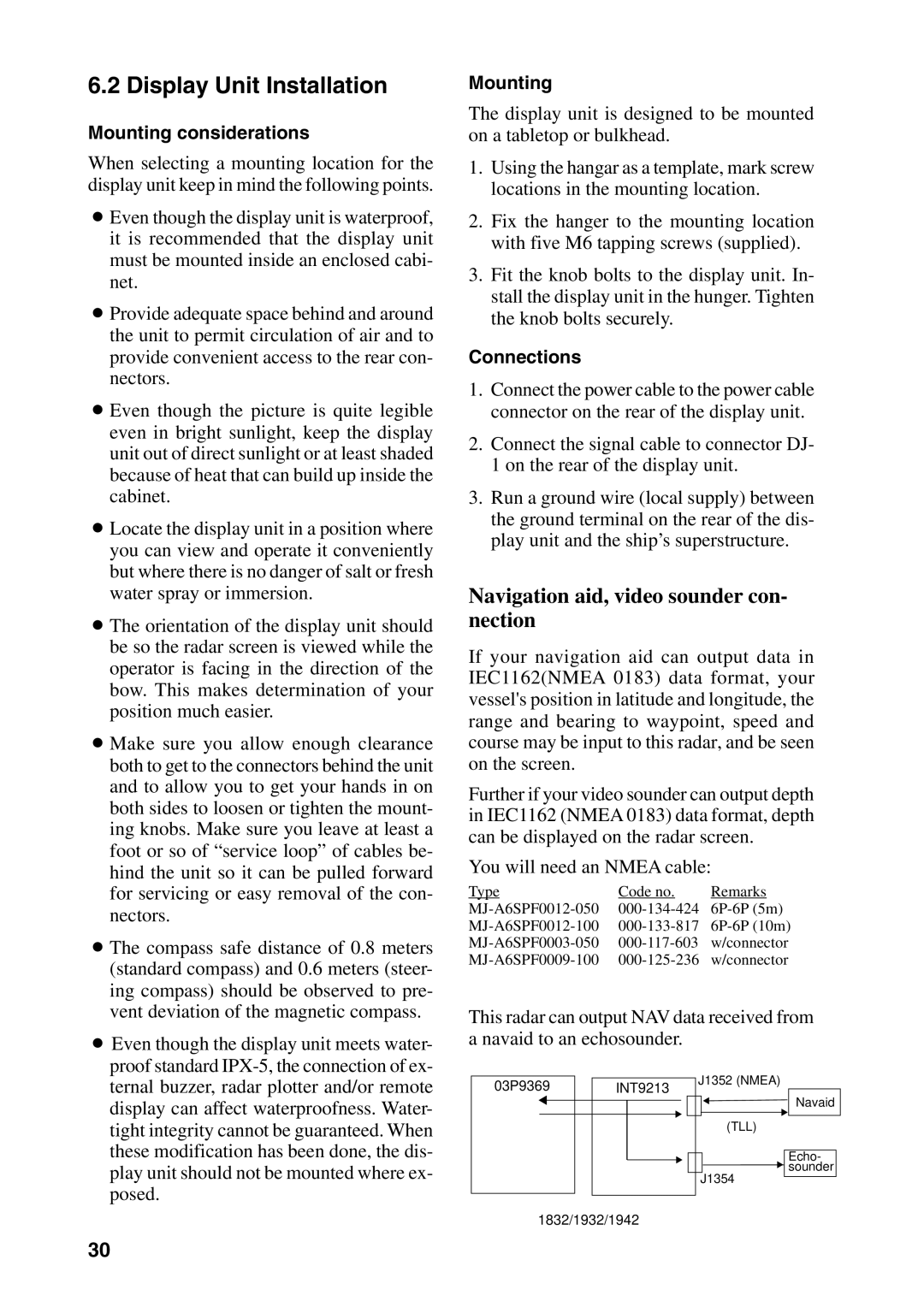
6.2 Display Unit Installation
Mounting considerations
When selecting a mounting location for the display unit keep in mind the following points.
¡Even though the display unit is waterproof, it is recommended that the display unit must be mounted inside an enclosed cabi- net.
¡Provide adequate space behind and around the unit to permit circulation of air and to provide convenient access to the rear con- nectors.
¡Even though the picture is quite legible even in bright sunlight, keep the display unit out of direct sunlight or at least shaded because of heat that can build up inside the cabinet.
¡Locate the display unit in a position where you can view and operate it conveniently but where there is no danger of salt or fresh water spray or immersion.
¡The orientation of the display unit should be so the radar screen is viewed while the operator is facing in the direction of the bow. This makes determination of your position much easier.
¡Make sure you allow enough clearance both to get to the connectors behind the unit and to allow you to get your hands in on both sides to loosen or tighten the mount- ing knobs. Make sure you leave at least a foot or so of “service loop” of cables be- hind the unit so it can be pulled forward for servicing or easy removal of the con- nectors.
¡The compass safe distance of 0.8 meters (standard compass) and 0.6 meters (steer- ing compass) should be observed to pre- vent deviation of the magnetic compass.
¡Even though the display unit meets water- proof standard
Mounting
The display unit is designed to be mounted on a tabletop or bulkhead.
1.Using the hangar as a template, mark screw locations in the mounting location.
2.Fix the hanger to the mounting location with five M6 tapping screws (supplied).
3.Fit the knob bolts to the display unit. In- stall the display unit in the hunger. Tighten the knob bolts securely.
Connections
1.Connect the power cable to the power cable connector on the rear of the display unit.
2.Connect the signal cable to connector DJ- 1 on the rear of the display unit.
3.Run a ground wire (local supply) between the ground terminal on the rear of the dis- play unit and the ship’s superstructure.
Navigation aid, video sounder con- nection
If your navigation aid can output data in IEC1162(NMEA 0183) data format, your vessel's position in latitude and longitude, the range and bearing to waypoint, speed and course may be input to this radar, and be seen on the screen.
Further if your video sounder can output depth in IEC1162 (NMEA 0183) data format, depth can be displayed on the radar screen.
You will need an NMEA cable:
Type | Code no. | Remarks | |
(5m) | |||
(10m) | |||
w/connector | |||
w/connector | |||
This radar can output NAV data received from a navaid to an echosounder.
03P9369 |
|
|
|
|
|
| J1352 (NMEA) | |||||
| INT9213 |
| ||||||||||
|
|
|
|
| Navaid | |||||||
|
|
|
|
|
|
|
|
|
|
|
| |
|
|
|
|
|
|
|
|
|
|
|
|
|
|
|
|
|
|
|
|
|
|
|
|
|
|
|
|
|
|
|
|
|
|
|
| (TLL) | ||
|
|
|
|
|
|
|
|
|
|
|
| Echo- |
|
|
|
|
|
|
|
|
|
|
|
| |
|
|
|
|
|
|
|
|
|
|
|
| sounder |
|
|
|
|
|
|
|
|
|
| J1354 | ||
|
|
|
|
|
|
|
|
|
|
|
|
|
|
|
|
|
|
|
|
|
|
|
|
|
|
1832/1932/1942
30
